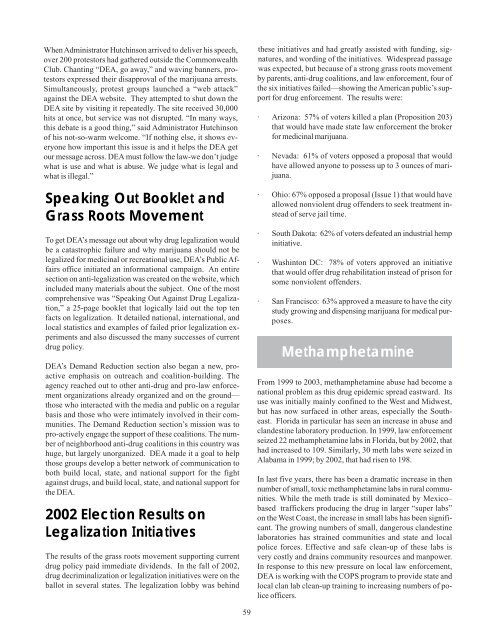Download This File - The Free Information Society
Download This File - The Free Information Society
Download This File - The Free Information Society
You also want an ePaper? Increase the reach of your titles
YUMPU automatically turns print PDFs into web optimized ePapers that Google loves.
When Administrator Hutchinson arrived to deliver his speech,<br />
over 200 protestors had gathered outside the Commonwealth<br />
Club. Chanting “DEA, go away,” and waving banners, protestors<br />
expressed their disapproval of the marijuana arrests.<br />
Simultaneously, protest groups launched a “web attack”<br />
against the DEA website. <strong>The</strong>y attempted to shut down the<br />
DEA site by visiting it repeatedly. <strong>The</strong> site received 30,000<br />
hits at once, but service was not disrupted. “In many ways,<br />
this debate is a good thing,” said Administrator Hutchinson<br />
of his not-so-warm welcome. “If nothing else, it shows everyone<br />
how important this issue is and it helps the DEA get<br />
our message across. DEA must follow the law-we don’t judge<br />
what is use and what is abuse. We judge what is legal and<br />
what is illegal.”<br />
Speaking Out Booklet and<br />
Grass Roots Movement<br />
To get DEA’s message out about why drug legalization would<br />
be a catastrophic failure and why marijuana should not be<br />
legalized for medicinal or recreational use, DEA’s Public Affairs<br />
office initiated an informational campaign. An entire<br />
section on anti-legalization was created on the website, which<br />
included many materials about the subject. One of the most<br />
comprehensive was “Speaking Out Against Drug Legalization,”<br />
a 25-page booklet that logically laid out the top ten<br />
facts on legalization. It detailed national, international, and<br />
local statistics and examples of failed prior legalization experiments<br />
and also discussed the many successes of current<br />
drug policy.<br />
DEA’s Demand Reduction section also began a new, proactive<br />
emphasis on outreach and coalition-building. <strong>The</strong><br />
agency reached out to other anti-drug and pro-law enforcement<br />
organizations already organized and on the ground—<br />
those who interacted with the media and public on a regular<br />
basis and those who were intimately involved in their communities.<br />
<strong>The</strong> Demand Reduction section’s mission was to<br />
pro-actively engage the support of these coalitions. <strong>The</strong> number<br />
of neighborhood anti-drug coalitions in this country was<br />
huge, but largely unorganized. DEA made it a goal to help<br />
those groups develop a better network of communication to<br />
both build local, state, and national support for the fight<br />
against drugs, and build local, state, and national support for<br />
the DEA.<br />
2002 Election Results on<br />
Legalization Initiatives<br />
<strong>The</strong> results of the grass roots movement supporting current<br />
drug policy paid immediate dividends. In the fall of 2002,<br />
drug decriminalization or legalization initiatives were on the<br />
ballot in several states. <strong>The</strong> legalization lobby was behind<br />
59<br />
these initiatives and had greatly assisted with funding, signatures,<br />
and wording of the initiatives. Widespread passage<br />
was expected, but because of a strong grass roots movement<br />
by parents, anti-drug coalitions, and law enforcement, four of<br />
the six initiatives failed—showing the American public’s support<br />
for drug enforcement. <strong>The</strong> results were:<br />
· Arizona: 57% of voters killed a plan (Proposition 203)<br />
that would have made state law enforcement the broker<br />
for medicinal marijuana.<br />
· Nevada: 61% of voters opposed a proposal that would<br />
have allowed anyone to possess up to 3 ounces of marijuana.<br />
· Ohio: 67% opposed a proposal (Issue 1) that would have<br />
allowed nonviolent drug offenders to seek treatment instead<br />
of serve jail time.<br />
· South Dakota: 62% of voters defeated an industrial hemp<br />
initiative.<br />
· Washinton DC: 78% of voters approved an initiative<br />
that would offer drug rehabilitation instead of prison for<br />
some nonviolent offenders.<br />
· San Francisco: 63% approved a measure to have the city<br />
study growing and dispensing marijuana for medical purposes.<br />
Methamphetamine<br />
From 1999 to 2003, methamphetamine abuse had become a<br />
national problem as this drug epidemic spread eastward. Its<br />
use was initially mainly confined to the West and Midwest,<br />
but has now surfaced in other areas, especially the Southeast.<br />
Florida in particular has seen an increase in abuse and<br />
clandestine laboratory production. In 1999, law enforcement<br />
seized 22 methamphetamine labs in Florida, but by 2002, that<br />
had increased to 109. Similarly, 30 meth labs were seized in<br />
Alabama in 1999; by 2002, that had risen to 198.<br />
In last five years, there has been a dramatic increase in then<br />
number of small, toxic methamphetamine labs in rural communities.<br />
While the meth trade is still dominated by Mexico–<br />
based traffickers producing the drug in larger “super labs”<br />
on the West Coast, the increase in small labs has been significant.<br />
<strong>The</strong> growing numbers of small, dangerous clandestine<br />
laboratories has strained communities and state and local<br />
police forces. Effective and safe clean-up of these labs is<br />
very costly and drains community resources and manpower.<br />
In response to this new pressure on local law enforcement,<br />
DEA is working with the COPS program to provide state and<br />
local clan lab clean-up training to increasing numbers of police<br />
officers.

















